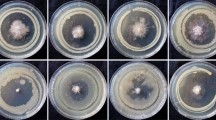Summary
Siderophores produced by rhizosphere bacteria may enhance plant growth by increasing the availability of Fe near the root or by inhibiting the colonization of roots by plant pathogens or other harmful bacteria. To examine the populations of siderophore-producing bacteria colonizing the roots of two grass species that differed in their susceptibility to Fe deficiency, we inoculated serial dilutions of root samples onto chrome azurol S (CAS) agar and several other selective and non-selective culture meida. CAS agar effectively differentiated bacteria that were capable of excreting large amounts of siderophore, but the composition of the medium limited its usefulness for ecological studies. A large proportion (71–79%) of the bacterial population that grew on a non-selective medium (tryptic soy agar) failed to grow on CAS agar, and several isolates that showed no sign of siderophore production on CAS agar produced siderophore in liquid culture. Similar populations of siderophore-producing bacteria were observed on roots of St. Augustine grass, which frequently exhibits Fe chlorosis, and bermuda grass, which does not. Roots of both grasses were colonized by bacteria that produced siderophore in vitro at concentrations ranging from 100 to 230 μM. The CAS assay solution was also used to compare siderophore production by Pseudomonas fluorescens Q6, an isolate from bermuda grass, and by P. putida B 10, a plant growth-promoting pseudomonad. P. fluorescens Q6 produced 2.4 times more siderophore in vitro than P. putida B 10.
Similar content being viewed by others
References
Alexander M (1977) Introduction to soil microbiology, 2nd edn. Wiley, New York
Becker JO, Hedges RW, Messens E (1985) Inhibitory effect of pseudobactin on the uptake of iron by higher plants. Appl Environ Microbiol 49:1090–1093
Buyer JS, Sikora LJ, Chaney RL (1989) A new growth medium for the study of siderophore-mediated interactions. Biol Fertil Soils 8:97–101
Cline GR, Reid CPP, Szanislo PJ (1984) Effects of a hydroxamate siderophore on iron absorption by sunflower and sorghum. Plant Physiol 76:36–39
Critchley IA, Basker MJ (1988) Conventional laboratory agar media provide an iron-limited environment for bacterial growth. FEMS Microbiol Lett 50:35–39
Crowley DE, Reid CPP, Szanislo PJ (1987) Microbial siderophores as iron sources for plants. In: Winkelmann G, van der Helm D, Neilands JB (eds) Iron transport in microbes, plants and animals. VCH Publ, New York, pp 375–386
Furia TE, Schenkel AG (1968) 2,4,4′-Trichloro-2′-hydroxydiphenyl ether: New, broad-spectrum bacteriostat. Soap Chem Spec, January, pp 47–50, 116–122
Geels FP, Schmidt EDL, Schippers B (1985) The use of 8-hydroxy-quinoline for the isolation and prequalification of plant growth-stimulating rhizosphere pseudomonads. Biol Fertil Soils 1:167–173
Hider RC (1984) Siderophore mediated absorption of iron. Struct Bonding 58:25–87
Jones D (1988) Composition and properties of the family Enterobacteriaceae. J Appl Bacteriol (Symp Suppl) 1S–19S
Lankford CE (1973) Bacterial assimilation of iron. Crit Rev Microbiol 2:273–331
Leong J (1986) Siderophores: Their biochemistry and possible role in the biocontrol of plant pathogens. Annu Rev Phytopathol 24:187–209
Lindsay WL, Schwab AP (1982) The chemistry of iron in soils and its availability to plants. J Plant Nutr 5:821–840
Maniatis T, Fritsch EF, Sambrook J (1982) Molecular cloning. Cold Spring Harbor Laboratory, Cold Spring Harbor, New York
Meyer JM, Abdallah MA (1978) The fluorescent pigment of Pseudomonas fluorescens: Biosynthesis, purification and physicochemical properties. J Gen Microbiol 107:319–328
Neilands JB (1981) Iron absorption and transport in microorganisms. Annu Rev Nutr 1:27–46
Neilands JB (1982) Microbial envelope proteins related to iron. Annu Rev Microbiol 36:285–309
Neilands JB (1984) Methodology of siderophores. Struct Bonding 58:1–24
Schwyn B, Neilands JB (1987) Universal chemical assay for the detection and determination of siderophores. Anal Biochem 160:47–56
Teintze M, Leong J (1981) Structure of pseudobactin A, a second siderophore from plant growth promoting Pseudomonas B 10. Biochemistry 20:6457–6462
Teintze M, Hossain MB, Barnes CL, Leong J, van der Helm D (1981) Structure of ferric pseudobactin, a siderophore from a plant growth promoting Pseudomonas. Biochemistry 20:6446–6456
Author information
Authors and Affiliations
Rights and permissions
About this article
Cite this article
Alexander, D.B., Zuberer, D.A. Use of chrome azurol S reagents to evaluate siderophore production by rhizosphere bacteria. Biol Fert Soils 12, 39–45 (1991). https://doi.org/10.1007/BF00369386
Received:
Issue Date:
DOI: https://doi.org/10.1007/BF00369386




